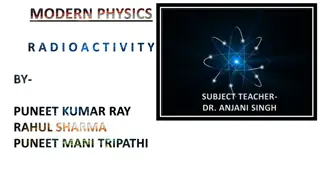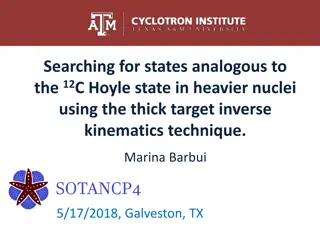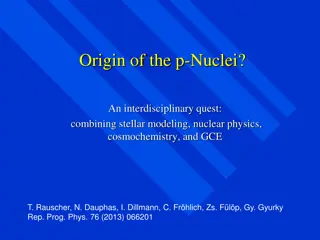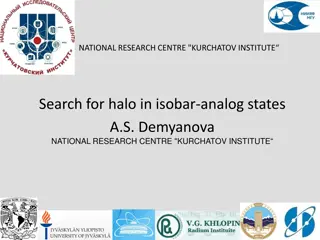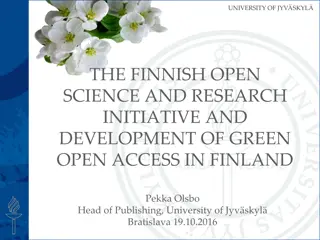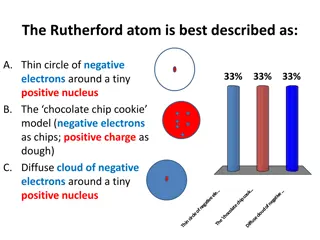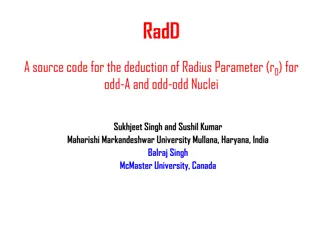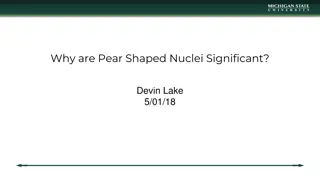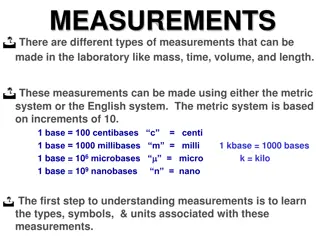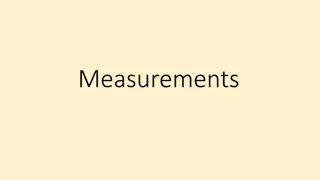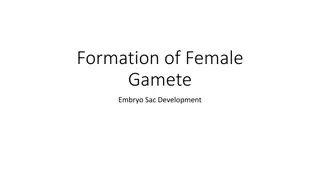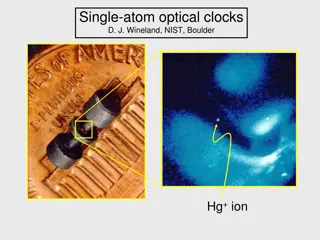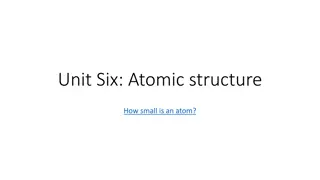Atomic Mass Measurements of Ultralow Q-Value Nuclei at University of Jyvaskyla
Explore the cutting-edge research on atomic mass measurements of ultralow Q-value nuclei conducted at the University of Jyvaskyla. This research delves into various techniques such as Penning trap atomic mass spectroscopy and PI-ICR to study Q-values for reactions and neutrino studies. The investigation includes experiments on tritium beta decay, ground-state decays, and decay energies, offering insights into the energy available in nuclear reactions. Dive into the world of ultralow Q-value nuclei and their significance in scientific exploration.
- Atomic Mass Measurements
- Ultralow Q-Value Nuclei
- University of Jyvaskyla
- Penning Trap
- Neutrino Studies
Download Presentation

Please find below an Image/Link to download the presentation.
The content on the website is provided AS IS for your information and personal use only. It may not be sold, licensed, or shared on other websites without obtaining consent from the author. Download presentation by click this link. If you encounter any issues during the download, it is possible that the publisher has removed the file from their server.
E N D
Presentation Transcript
JYVSKYLN YLIOPISTO 39th Erice School 2017 ATOMIC MASS MEASUREMENTS OF ULTRALOW Q-VALUE NUCLEI Tommi Eronen University of Jyv skyl
JYVSKYLN YLIOPISTO OUTLINE Q-value from atomic mass spectrometry Nuclei with potential ultralow Q-value (On-line) Penning trap atomic mass spectroscopy +PI-ICR technique Program at JYFLTRAP, Jyv skyl Q-value for a reaction is the amount of energy released by that reaction. 16.9.2024
JYVSKYLN YLIOPISTO Q-value from mass spectroscopy Provides the FULL energy available ? = ??????? ????? ??? Tritium beta decay electron spectrum from parent-daughter mass difference
JYVSKYLN YLIOPISTO Q-values from masses for neutrino studies Several cases already studied.. 2 , 0 0 ECEC Search for resonant enhancement Now: Ordinary (highly forbidden) and EC decays Ground-state-to-ground state decays: Direct neutrino mass probes, e.g. tritium, 163Ho Ground-state-to-excited-state decays Low Q-values of highly forbidden decays
JYVSKYLN YLIOPISTO Low Q-value For example EC Q-value of 163Ho (?1/2 4600 years) Ground state to ground state decay Q-value from Penning trap mass spectroscopy Eliseev et al., PRL 115, 062501 (2015) [PI-ICR technique] 16.9.2024
JYVSKYLN YLIOPISTO Ultralow Q-value nuclei Single -and EC capture decays Decay with very low Q-value to an excited state Bigger fraction of the Q-value in neutrino mass Search for slightly positive Q-value -/EC Q-value parent excited state mass excitation energy difference Ground state Daughter
JYVSKYLN YLIOPISTO Required experimental quantities Parent-daughter decay Q-value mass difference From mass spectroscopy Daughter excited state excitation energy -/EC Q-value parent excited state mass excitation energy difference Ground state Daughter
JYVSKYLN YLIOPISTO Immediate improvement With precise Mass difference measurement Candidates Half-lives range from few hours to few days J. Suhonen, Phys. Scr. 89, 054032 (2014).
JYVSKYLN YLIOPISTO 115In decay Cattadori et al. Nucl. Phys A 748, 333 (2005) Q-values: JYFLTRAP 350(170) eV E. Wieslander, J. Suhonen, T. Eronen et al. PRL 103, 122501 (2009) FSU-TRAP 155(24) eV B.J. Mount, M. Redshav, E.G. Myers, PRL 103, 122502 (2009)
JYVSKYLN YLIOPISTO Precisions The goal: Find slightly positive Q-value cases: Phase 1: Coarse selection Daughter state excitation energies < 100 eV ~100 eV gs-gs precision with Penning traps (TOF-ICR) Phase 2: Finer selection If survived phase 1 Daughter state excitation energies < 10 eV ~10-50 eV gs-gs precision with Penning traps (PI-ICR) Phase 3: Ultimate Push to eV-level with non-destructive Penning trap mass measurement techniques E.g. with PENTATRAP in MPIK, Heidelberg
JYVSKYLN YLIOPISTO Production of ions of interest Half-lives few days up to few years Need (near) on-line production IGISOL facility at Uni Jyv skyl accelerator lab K130 and K30 cyclotrons Proton/deuteron induced fusion reactions E.g. 77As production: 76Ge(d,n)77As @ 7 MeV
JYVSKYLN YLIOPISTO IGISOL IGISOL Ion Guide Isotope Separator OnLine ISOL-system for all elements, fast ( ~ms) Stopping reaction products into (helium) gas Extraction as ions no need to reionize But: relatively low efficiency Different geometries for Light-ion fusion Fusion evaporation p/d fission n-induced fission Cryogenic
JYVSKYLN YLIOPISTO Parent and daughter production For example77As -> 77Se Q-value Parent: 76Ge(d,n)77As @ 7 MeV Daughter: stable selenium exists as a contaminant BOTH available simultaneously
JYVSKYLN YLIOPISTO IGISOL-4 FACILITY LAYOUT From K130 cyclotron MCC30/15 light-ion cyclotron Atom trap Dipole magnet ?/ ? 350 30 keV IGISOL-4 target area RFQ cooler/buncher Decay Spectroscopy station JYFLTRAP, Double Penning Trap High precision mass measurements Isobaric/Isomeric purification of RIB Trap assisted spectroscopy High purity ion samples Collinear laser Spectroscopy 2014-03-12 Post-trap decay spec
JYVSKYLN YLIOPISTO JYFLTRAP Buncher 2 Penning traps Purification trap Precision trap 30 keV buncher 30 keV Penning traps
JYVSKYLN YLIOPISTO Penning trap confining charged particles Three eigenmotions Axial z Magnetron - Modified cyclotron +
JYVSKYLN YLIOPISTO Free-space cyclotron frequency Mass measurements through SIDEBAND FREQUENCY: G. Gabrielse, Int. J. Mass. Spec. 279 (2009) 107 112
JYVSKYLN YLIOPISTO Q-value from cyclotron frequencies daughter Frequency ratio experimental quantity Q-value (for singly charged ions) parent For same A/q: parent daughter
JYVSKYLN YLIOPISTO Time-of-flight ion cyclotron resonance (TOF-ICR) method for mass measurements - phase 1
JYVSKYLN YLIOPISTO Example resonances,
JYVSKYLN YLIOPISTO Phase imaging ion cyclotron resonance (PI-ICR) method for mass measurements phase 2
JYVSKYLN YLIOPISTO PI-ICR method Novel Penning trap mass measurement technique Developed by Sergey Eliseev, MPIK Heidelberg at SHIPTRAP GSI Faster by 40x
JYVSKYLN YLIOPISTO PI-ICR at JYFLTRAP Detector installed in June 2017 Trap center
JYVSKYLN YLIOPISTO PI-ICR scheme for mass measurements
JYVSKYLN YLIOPISTO PI-ICR results SHIPTRAP at GSI: 163Ho-163Dy Q-value with uncertainty 30stat + 15syst eV Eliseev et al., PRL 115, 062501 (2015) JYFLTRAP test measurement 85Rb-87Rb 52 eV precision (preliminary, room for improvement) This is better than 10-9 ! In general: few ten eV precision available (few x 10-10 frequency ratio precision) 16.9.2024
JYVSKYLN YLIOPISTO After Q-value measurement.. J. Suhonen et al. will be busy for a while Branching ratio A potential case will have Very low Q-value (< 100 eV) Reasonable branching ratio Low background near the endpoint With very small Q-value atomic effects might interfere with beta decay
JYVSKYLN YLIOPISTO Final remarks IGISOL + JYFLTRAP is the ideal facility for low Q- value measurements Easy production, cheap beamtime Simultaneous availability of parent, daughter (A/q doublet mass measurement) PI-ICR technique allows to push to ~20 eV level 11 days of beamtime approved for 6 cases Collaboration with J. Suhonen s group
JYVSKYLN YLIOPISTO Advertisement Isomerically clean beams available with unprecedented resolution! Phase-sensitive cleaning For A/q = 100 50 keV isomer 45 deg phase difference Need 200 ms 250 ms
JYVSKYLN YLIOPISTO Acknowledgments http://research.jyu.fi/igisol EXPERIMENT: L. Canete T. Eronen S. Geldhof A. Jokinen A. Kankainen I.D. Moore D. Nesterenko H. Penttil I. Pohjolainen A. de Roubin M. Reponen S. Rinta-Antila A. Takkinen M. Vilen J. yst THEORY: J. Suhonen M. Haaranen J. Kostensalo J. Kotila P. C. Srivastava (Roorkee, India) Thank you!




